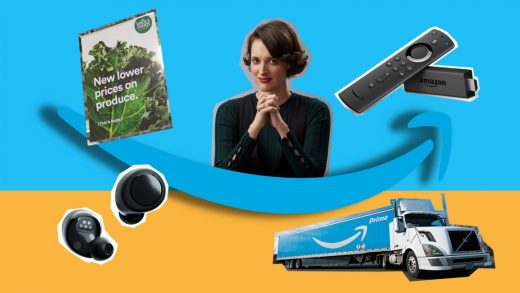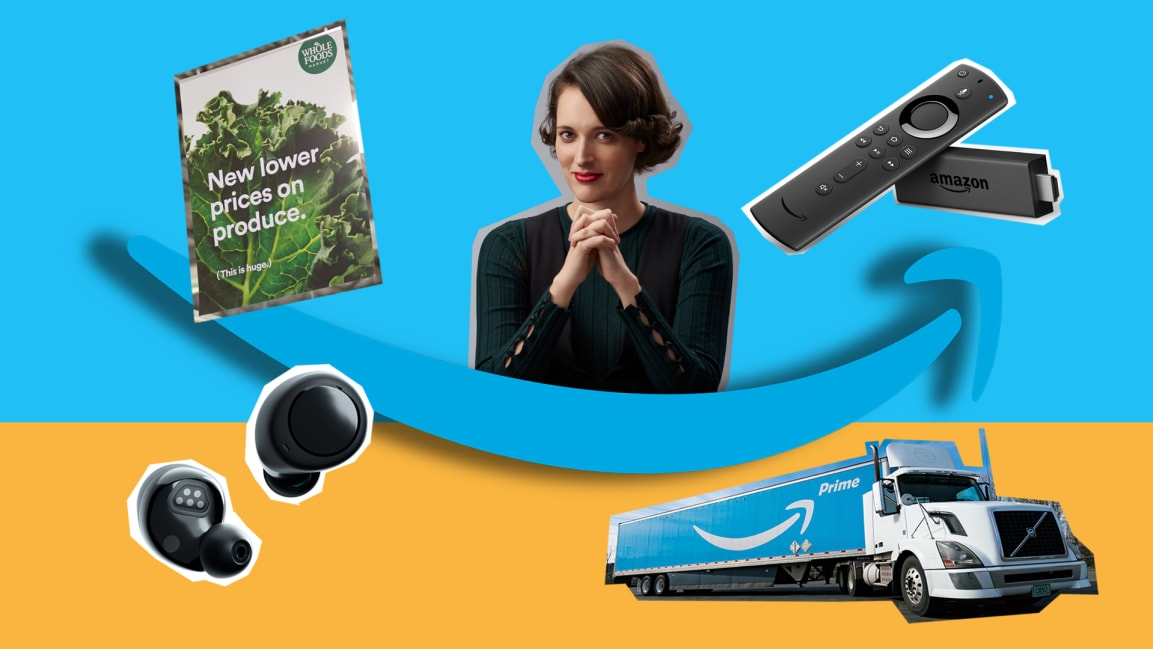5 things Amazon got right in 2019–and 5 it got wrong
Amazon isn’t a company whose behavior is easy to categorize.
While Amazon likes to boast about its “customer obsession,” sometimes that focus comes at a cost to the greater good. The convenience of devices like Amazon Echo smart speakers and the Ring doorbell, for instance, have introduced new costs to privacy, and the push for ever-faster shipping puts a greater burden on Amazon’s already-strained workforce.
This year provided several examples in which Amazon’s biggest successes came with serious ramifications. With that in mind, let’s look back at what Amazon got right and wrong in 2019:
Good: The hardware incursion continues
Amazon’s Alexa devices continued to dominate the smart speaker wars this year, both in the United States and worldwide. And its Fire TV streaming platform has surpassed Roku in active users. Now, Amazon is building on that success by expanding into new areas, including Alexa earbuds, eyeglasses, and even a voice-activated ring, while also refining its current lineup with better-sounding Echo speakers and more powerful Fire TV devices.
Just as importantly, Amazon is creating a stronger ecosystem around those products. The new Echo Studio speaker, for instance, can pair with other Echo speakers to create an audio system for Fire TV devices, and a feature called Alexa Guard lets Echo speakers listen for the sound of smoke alarms or broken glass. Amazon added parental control features to Alexa as well, along with a kid-friendly Echo Dot speaker. Heading into 2020, no other company’s vision for voice control is quite as cohesive.
Bad: Ring’s privacy non-response
A few months ago, Amazon announced a bunch of new privacy features for Alexa in response to customers’ growing unease over smart speakers. Users can now auto-delete recordings on a rolling three-month or 18-month basis, and they can also ask Alexa to immediately delete anything they’ve said on a given day. “We’re investing in privacy across the board,” explained Dave Limp, Amazon’s head of hardware and services.
No such investment seems to exist within Amazon’s Ring subsidiary. Through its popular doorbell cameras, it’s helped police surveil communities without warrants. Although users must explicitly approve law enforcement requests for footage, a string of reporting this year has shown how Ring has coached police departments on getting more videos, and how police can locate Ring users who have turned down requests. And by Amazon’s admission, it makes no effort to recover or delete users’ recordings once they’re in the hands of police. Ring’s resulting privacy and civil liberties concerns seem a lot more serious than the ones Alexa is creating, yet Ring has announced no major changes to how its police programs work.
Good: Getting serious with groceries
Amazon gave grocery stores more reasons to be nervous this year. In April, the company announced price cuts on hundreds of items at Whole Foods, with a major focus on produce, and expanded its weekly grocery deals program for Prime members. And in October, it expanded its free grocery delivery program to more than 20 major metro areas, many of which had previously required a $15 per month Amazon Fresh subscription.
While Amazon’s moves could prompt more antitrust scrutiny–more on that later–it also may have encouraged innovation from rivals. As Bloomberg reported this month, other grocery chains are investing in new technology such as mobile checkout and automated delivery warehouses in hopes of staying a step ahead.
Bad: Retail’s failure to regulate
In August, a Wall Street Journal investigation by Alexandra Berzon, Shane Shifflett, and Justin Schreck turned up thousands of Amazon Marketplace listings for products that were either mislabeled, declared unsafe, or banned by federal regulators. A separate report by CNBC’s Annie Palmer in October turned up widespread complaints about merchants selling expired food. And our own Glenn Fleishman reported on dangerous low-cost laser cutters available from Marketplace sellers—some of which Amazon removed after we brought them to its attention.
As the WSJ argued, this is yet another example of a major tech company failing to police its platform, echoing how Google, Twitter, and Facebook have struggled to curb misinformation. It may already be having real-world ramifications: Last month, Nike stopped selling products directly from Amazon, reportedly in part because the brand grew tired of competing with counterfeit and unlicensed third-party listings.
Good: Burying the hatchet with YouTube
After Google and Amazon declared war on one another’s streaming platforms in 2017, the companies found their way to a truce this year. Google has released official YouTube and YouTube TV apps on Amazon’s Fire TV devices, and a YouTube Kids app is also on the way. Amazon, meanwhile, has brought Prime Video support to Chromecast and Android TV devices, and has allowed Chromecast and certain Nest products into its retail store.
The cold war continues in some areas. You won’t find Google’s smart speakers on Amazon’s website, for instance, and other Google apps such as Google Photos and YouTube Music remain unavailable on Fire TV devices. Still, at least the companies realized that withholding their respective video services from one another’s platforms wasn’t beneficial for anyone.
Bad: Antitrust probes galore
Like other major tech firms, Amazon has become a target of antitrust probes this year, both in the United States and abroad. The Federal Trade Commission is reportedly examining whether Amazon unfairly favors its own products over those of third-party merchants on its site, and may have expanded its probe to Amazon’s wildly profitable AWS cloud computing business. The European Union, meanwhile, has announced its own wide-ranging antitrust investigation, looking at whether Amazon is harvesting marketplace seller data for an unfair advantage, among other things. That investigation comes in spite of a settlement with Germany’s antitrust authority over Amazon’s terms of service for third-party sellers.
It’s still early days for these probes, and Amazon may not have been able to avert the broader mistrust of tech giants that led to this point. But the company’s recent history of pushing around brands and upending resale markets without notice probably hasn’t helped.
Good: Prime video successes
Amazon Prime Video has always been an also-ran in the TV streaming wars, with a decent selection of movies but few showstopping originals. This year, however, Amazon’s series are starting to get some buzz. The Marvelous Mrs. Maisel and Fleabag both cleaned up at the Emmys, while The Boys and season 4 of The Expanse (the latter saved from cancellation on basic cable) have earned critical acclaim. Turns out Amazon might not have to wait for that Lord of the Rings prequel to put its original programming on the map.
Bad: The HQ2 collapse
After a year-long contest in which city and state officials dangled offers of special tax breaks and other incentives, Amazon announced in late 2018 that it had selected New York City and Arlington, Virginia for its second headquarters. The announcement quickly triggered a backlash in New York, as protestors argued that the megadeal would further strain the city’s education, transportation, and housing systems for little in return. With public support collapsing, Amazon abandoned its New York plan in February, giving up about $3 billion in tax breaks from the city and state (though it is now leasing office space on a much smaller scale).
As Recode’s Jason Del Rey argued, one could imagine an alternate outcome in which Amazon made compromises to satisfy its critics, but that’s not really the company’s nature. The alternative, however, was embarrassment for Amazon and the elected officials that prostrated themselves to get a deal done.
Good: New shipping perks
If you’ve noticed more Amazon orders arriving earlier this year, it’s no coincidence. In April, Amazon began expanding the number of products it ships with one-day delivery for Prime members, including many products that used to only ship as add-ons to pricier orders. The company now says it offers free one-day shipping in more than 10 million products.
Amazon also started offering in-garage delivery for customers with smart garage door openers, which is slightly less creepy than letting deliveries in through the front door when you’re not home.
Bad: Stretching workers to the limit
While faster free shipping might be a boon for Amazon’s customers, it may also put a heavy burden on workers who in some cases are already at a breaking point. As BuzzFeed and ProPublica reported this year, Amazon’s relentless demands have prompted some delivery contractors to sacrifice safety, pressuring drivers to skip meals, avoid breaks, and ignore speed limits. Amazon cut ties with the offending contractors after those reports emerged, but drivers say safety problems still exist.
The unrelenting pace at Amazon’s warehouses doesn’t sound any better. Last month, The Atlantic reported that serious injury rates at one warehouse that were four times higher than the industry average. The story also documented efforts by some managers to avoid having medical issues recorded or reported. Amazon, however, insists that nothing is wrong, and has even claimed that union groups are exploiting workers’ horror stories to extract higher membership dues. In other words, don’t expect much in the way of systemic change until automation takes humans out of the equation entirely.
(22)



